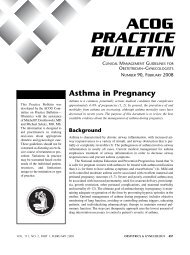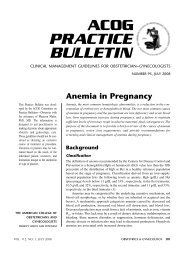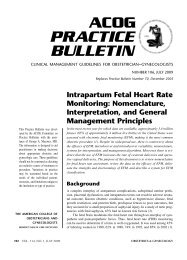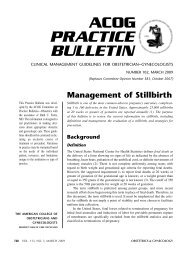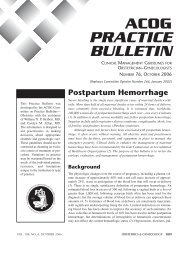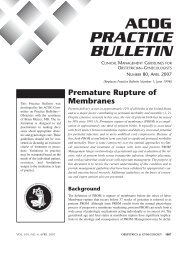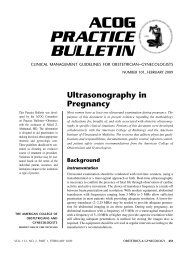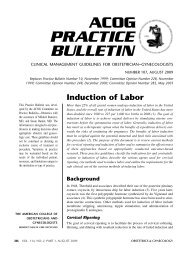ACOG Practice Bulletin No. 82: Management of Herpes in Pregnancy
ACOG Practice Bulletin No. 82: Management of Herpes in Pregnancy
ACOG Practice Bulletin No. 82: Management of Herpes in Pregnancy
You also want an ePaper? Increase the reach of your titles
YUMPU automatically turns print PDFs into web optimized ePapers that Google loves.
delivery was reduced by 75%, and the rate <strong>of</strong> cesarean<br />
delivery for recurrent genital herpes was reduced by 40%<br />
for women who received suppression therapy after 36<br />
weeks <strong>of</strong> gestation. Viral detection at delivery us<strong>in</strong>g culture<br />
or PCR was reduced by 90% among treated women,<br />
but shedd<strong>in</strong>g was not completely elim<strong>in</strong>ated (<strong>in</strong> one trial,<br />
virus was detected <strong>in</strong> one woman receiv<strong>in</strong>g acyclovir)<br />
(13). There were no cases <strong>of</strong> neonatal herpes <strong>in</strong> any <strong>of</strong> the<br />
studies. Several trials demonstrat<strong>in</strong>g similar efficacy <strong>of</strong><br />
valacyclovir have been published s<strong>in</strong>ce the meta-analysis<br />
(12, 43). Women with active recurrent genital herpes<br />
should be <strong>of</strong>fered suppressive viral therapy at or beyond<br />
36 weeks <strong>of</strong> gestation. The doses <strong>of</strong> antiviral medication<br />
used <strong>in</strong> the randomized trials <strong>in</strong> pregnancy are higher<br />
than the correspond<strong>in</strong>g doses <strong>in</strong> nonpregnant women.<br />
(Table 1.) Although neutropenia is a recognized, transient<br />
complication <strong>of</strong> acyclovir treatment <strong>of</strong> neonatal<br />
HSV <strong>in</strong>fection, it has not been reported follow<strong>in</strong>g maternal<br />
suppressive therapy (17). The acyclovir concentrations<br />
at which neutropenia occurred were approximately<br />
5–30 times higher than were observed <strong>in</strong> umbilical ve<strong>in</strong><br />
plasma <strong>in</strong> a pharmacok<strong>in</strong>etic study <strong>of</strong> valacyclovir <strong>in</strong><br />
pregnancy (44).<br />
What medications are available for treatment<br />
<strong>of</strong> herpes simplex virus <strong>in</strong>fection dur<strong>in</strong>g<br />
pregnancy<br />
There are three antiviral agents that are commonly used<br />
to treat HSV <strong>in</strong>fections. Acyclovir, famciclovir, and valacyclovir<br />
are all FDA pregnancy category B medications.<br />
These drugs are all approved for the treatment <strong>of</strong> primary<br />
genital herpes, the treatment <strong>of</strong> episodes <strong>of</strong> recurrent disease,<br />
and the daily treatment for suppression <strong>of</strong> outbreaks<br />
<strong>of</strong> recurrent genital herpes.<br />
Acyclovir is a nucleoside analogue that enters virally<br />
<strong>in</strong>fected cells and acts specifically to <strong>in</strong>hibit the viral<br />
thymid<strong>in</strong>e k<strong>in</strong>ase and, thus, DNA replication. The<br />
bioavailability <strong>of</strong> oral acyclovir is approximately 20%,<br />
which necessitates more frequent dosage <strong>in</strong>tervals (45).<br />
Valacyclovir is a prodrug <strong>of</strong> acyclovir and is rapidly converted<br />
to acyclovir after metabolism <strong>in</strong> the liver. The<br />
bioavailability <strong>of</strong> acyclovir after doses with valacyclovir<br />
is approximately 54% (46). This is three to five times<br />
higher than achieved with oral acyclovir and, at a dose <strong>of</strong><br />
1 gm, approximates levels achieved with <strong>in</strong>travenous<br />
doses <strong>of</strong> acyclovir. The pharmacok<strong>in</strong>etics <strong>of</strong> both drugs<br />
have been evaluated <strong>in</strong> pregnancy. After doses <strong>of</strong> acyclovir<br />
and valacyclovir, there was evidence <strong>of</strong> acyclovir<br />
concentration <strong>in</strong> the amniotic fluid but no evidence <strong>of</strong><br />
preferential fetal drug accumulation (44, 47).<br />
Famciclovir also is a prodrug that is rapidly transformed<br />
<strong>in</strong>to penciclovir <strong>in</strong> the body. The bioavailability <strong>of</strong> the<br />
active drug from an oral dose is approximately 77%, so<br />
the dosage <strong>in</strong>terval is less frequent than with acyclovir<br />
(48). There are no published data on the use <strong>of</strong> famciclovir<br />
<strong>in</strong> pregnancy.<br />
Development <strong>of</strong> viral resistance to acyclovir has not<br />
been a problem <strong>in</strong> immunocompetent patients. In two<br />
large, laboratory-based studies, a very low prevalence <strong>of</strong><br />
acyclovir resistance <strong>in</strong> viruses isolated from immunocompetent<br />
patients has been estimated (0.3–0.6%),<br />
whereas acyclovir-resistant HSV <strong>in</strong>fections occur more<br />
commonly among patients who are immunocompromised<br />
(6–7%) (49, 50).<br />
There are no documented <strong>in</strong>creases <strong>in</strong> adverse fetal<br />
effects because <strong>of</strong> medication exposure (39, 50, 51). The<br />
manufacturer <strong>of</strong> acyclovir and valacyclovir, <strong>in</strong> cooperation<br />
with the Centers for Disease Control and Prevention,<br />
ma<strong>in</strong>ta<strong>in</strong>ed a registry for exposure to these drugs dur<strong>in</strong>g<br />
pregnancy through 1999. More than 700 <strong>in</strong>fants reported<br />
were exposed to acyclovir dur<strong>in</strong>g the first trimester, and<br />
there was no <strong>in</strong>crease <strong>in</strong> adverse fetal or neonatal effects,<br />
although the safety has not been def<strong>in</strong>itely established<br />
(18). There are <strong>in</strong>sufficient data on valacyclovir and famciclovir<br />
exposure <strong>in</strong> the pregnancy registry for analyses<br />
(52). Topical therapy <strong>of</strong>fers limited benefit and should be<br />
discouraged.<br />
Is there a role for rout<strong>in</strong>e screen<strong>in</strong>g for<br />
genital herpes dur<strong>in</strong>g pregnancy or at<br />
delivery<br />
In the past, screen<strong>in</strong>g referred to the use <strong>of</strong> a viral detection<br />
method, most commonly culture, to assess whether<br />
viral shedd<strong>in</strong>g was present. Asymptomatic shedd<strong>in</strong>g dur<strong>in</strong>g<br />
the antepartum period does not predict asymptomatic<br />
shedd<strong>in</strong>g at delivery (53, 54). Thus, rout<strong>in</strong>e antepartum<br />
genital HSV cultures <strong>in</strong> asymptomatic patients with<br />
recurrent disease are not recommended.<br />
With the advent <strong>of</strong> serologic tests that can reliably<br />
detect disease <strong>in</strong> asymptomatic patients, screen<strong>in</strong>g now<br />
refers to the detection <strong>of</strong> HSV <strong>in</strong>fection. Maternal HSV<br />
screen<strong>in</strong>g has been proposed to reduce neonatal herpes<br />
by identify<strong>in</strong>g women <strong>in</strong>fected (seropositive) with genital<br />
herpes and <strong>of</strong>fer<strong>in</strong>g suppressive antiviral therapy near<br />
term. It also may identify susceptible women (seronegative)<br />
whose partners could be <strong>of</strong>fered screen<strong>in</strong>g, allow<strong>in</strong>g<br />
for counsel<strong>in</strong>g <strong>of</strong> at-risk couples about strategies to<br />
reduce the possibility <strong>of</strong> new maternal <strong>in</strong>fection dur<strong>in</strong>g<br />
pregnancy. Several analyses have evaluated the costeffectiveness<br />
<strong>of</strong> various screen<strong>in</strong>g protocols for pregnant<br />
patients to reduce the <strong>in</strong>cidence <strong>of</strong> neonatal HSV <strong>in</strong>fection<br />
(55–59). The results from these analyses are highly<br />
variable—estimates <strong>of</strong> the cost to prevent one case <strong>of</strong><br />
neonatal herpes range from $200,000 to $4,000,000.<br />
VOL. 109, NO. 6, JUNE 2007 <strong>ACOG</strong> <strong>Practice</strong> <strong>Bullet<strong>in</strong></strong> <strong>Management</strong> <strong>of</strong> <strong>Herpes</strong> <strong>in</strong> <strong>Pregnancy</strong> 1493



